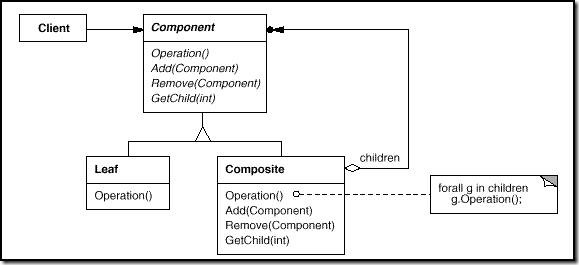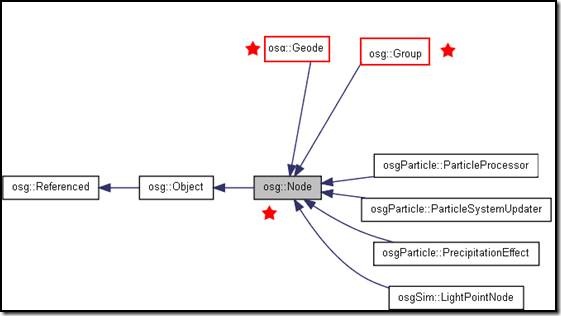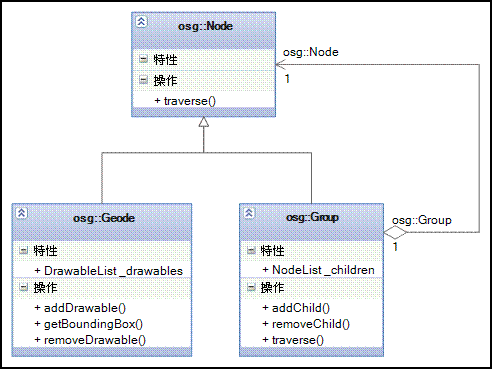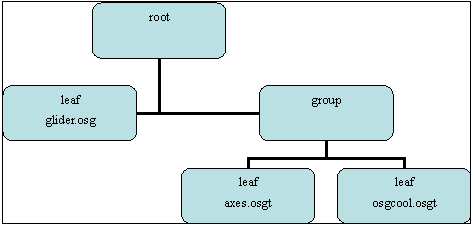OpenSceneGraph 場景節(jié)點(diǎn)
一、OSG場景節(jié)點(diǎn)簡介及組合模式介紹
OSG中的場景是樹形結(jié)構(gòu)表示的層次結(jié)構(gòu)��,如下圖所示:

Figure 1.1 OpenSceneGraph場景樹形層次結(jié)構(gòu)
根據(jù)其源碼中的注釋得知����,OSG中場景節(jié)點(diǎn)的管理采用了組合(Composite)模式。先簡要介紹一下組合模式��,其類圖為:

Figure 1.2 Composite Pattern's Structure
使用組合模式的目的是為了將對象合成樹形結(jié)構(gòu)以表示“部分—整體”的層次結(jié)構(gòu)��。Composite使得用戶對單個對象和組合的使用具有一致性��。組合模式通常用于以下情況:
l 你想表示對象的部分—整體層次結(jié)構(gòu);
l 你希望用戶忽略組合對象與單個對象的不同��,用戶將統(tǒng)一地使用組合結(jié)構(gòu)中的所有對象��;
為了達(dá)到葉子節(jié)點(diǎn)與組合節(jié)點(diǎn)的一致性�,也可以給葉子節(jié)點(diǎn)定義與組合節(jié)點(diǎn)一樣的操作�,但是這些操作什么也不做,與引入Null Object模式類似�,這里引入Null Operation����。
組合模式中主要的參與者有三個:
l Component
n Declares the interface for objects in the composition�;
n Implements default behavior for the interface common to all classes, as appropriate;
n Declares and interface for accessing and managing its child components;
n (optional)Defines an interface for accessing a component's parent in the recursive structure and implements it if that's appropriate;
l Leaf
n Represents leaf objects in the composition. A leaf has no children;
n Defines behavior for primitive objects in the composition;
l Composite
n Defines behavior for components having children;
n Stores child components;
l Client
n Manipulates objects in the composition through the Component interface.
二、OSG中組合Composite模式的應(yīng)用
根據(jù)OSG的文檔得到其場景節(jié)點(diǎn)的類圖����,如下圖所示:

Figure 1.3 Inheritance Diagram for osg::Node
結(jié)合紅星標(biāo)示出的三個類:osg::Node����、osg::Geode����、osg::Group來講述組合模式的具體應(yīng)用。以下為聲明類osg::Node時給出的注釋:
/** Base class for all internal nodes in the scene graph.
Provides interface for most common node operations (Composite Pattern).
*/
即osg::Node類為所有場景圖形的基類�,為大多數(shù)能用節(jié)點(diǎn)操作提供接口����,采用提組合模式����。
以下為聲明類osg::Geode時給出的注釋:
/** A \c Geode is a "geometry node", that is, a leaf node on the scene graph
* that can have "renderable things" attached to it. In OSG, renderable things
* are represented by objects from the \c Drawable class, so a \c Geode is a
* \c Node whose purpose is grouping <tt>Drawable</tt>s.
*/
即osg::Geode類是一個幾何節(jié)點(diǎn)��,即場景節(jié)點(diǎn)中的一個葉子節(jié)點(diǎn)��,可以把可渲染的東西綁定在它上面。在OSG中,可渲染的東西表示為由類Drawable生成的對象。所以�,一個Geode目的就是使Drawable成組�。具體實現(xiàn)的程序代碼為:
typedef std::vector< ref_ptr<Drawable> > DrawableList;
保護(hù)成員變量:
DrawableList _drawables;
以下為聲明類osg::Group時給出的注釋:
/** General group node which maintains a list of children.
* Children are reference counted. This allows children to be shared
* with memory management handled automatically via osg::Referenced.
*/
即osg::Group節(jié)點(diǎn)維護(hù)一個孩子表��,孩子是引用計數(shù)的��。這樣就可以由內(nèi)存管理機(jī)制來管理這些孩子。具體實現(xiàn)的程序代碼為:
typedef std::vector< ref_ptr<Node> > NodeList;
保護(hù)成員變量:
NodeList _children;
綜上所述,得出它們的類圖:

Figure 1.4 OSG Node Class Diagram
由類圖可知��,這個類圖與圖1.2所示的組合模式的類圖相似�。其中,類osg::Node可以看成是Component類,為所有的場景節(jié)點(diǎn)的通用操作聲明接口�;osg::Geode類可看作Leaf類����,是一個具體的可渲染的場景節(jié)點(diǎn)�;osg::Group類可看作Composite類,它可以包含葉節(jié)點(diǎn)或其它節(jié)點(diǎn)。
三、程序示例
編程實現(xiàn)由多個模型來構(gòu)成一個場景����,為了簡便起見��,模型由文件得到。場景的樹形層次結(jié)構(gòu)如下圖所示:

Figure 1.5 Add More Models to Scene Graph
程序代碼如下:
//--------------------------------------------------------------------------
// Copyright (c) 2012 eryar All Rights Reserved.
//
// File : Main.cpp
// Author : eryar@163.com
// Date : 2012-1-3 20:58
// Version : 1.0v
//
// Description : Add more models to the Secne.
//
//==========================================================================
#include <osg/Node>
#include <osgDB/ReadFile>
#include <osgViewer/Viewer>
#include <osgViewer/ViewerEventHandlers>
int main(int argc, char* argv[])
{
osgViewer::Viewer viewer;
osg::ref_ptr<osg::Group> root = new osg::Group;
osg::ref_ptr<osg::Group> group = new osg::Group;
root->addChild(osgDB::readNodeFile("glider.osg"));
group->addChild(osgDB::readNodeFile("osgcool.osgt"));
group->addChild(osgDB::readNodeFile("axes.osgt"));
root->addChild(group);
viewer.setSceneData(root);
viewer.realize();
viewer.addEventHandler(new osgViewer::WindowSizeHandler);
viewer.addEventHandler(new osgViewer::StatsHandler);
return viewer.run();
}
程序效果圖如下圖所示:

Figure 1.6 Render OSG Node